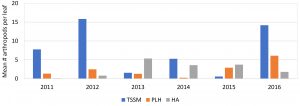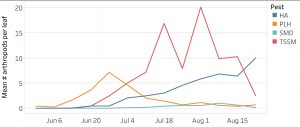Excited for the 2017 growing season? We are…and so are the bugs!
We recently published our final Organic Hop Variety Trial Report that includes 6 years of data on disease, weed, and insect pest populations found in our hopyard, as well as yield and quality performance of more than 20 hop varieties we evaluated.
Our research showed seasonal patterns of the three major arthropod pests of hops found in the Northeast:
- Two-Spotted Spider Mites (TSSM),
- Potato Leafhoppers (PLH), and
- Hop Aphids (HA).

We also looked at beneficial insects, including the Spider-Mite Destroyer and its habits.
We found that that the incidence of each pest varies widely by year, based on weather conditions. For example, TSSM populations responded to the warm and dry conditions we experienced in 2012 and 2016, while HA populations tended to favor cool and moist conditions.
PLH seemed to get a big boost out of a warm winter. Because they migrate from the south each season, warmer winters allow PLH to over-winter further north, shortening their journey to Vermont in the spring and early summer.

Our research also tracked pest levels throughout each growing season. While overall pest numbers varied greatly from year to year, the populations for each pest usually peaked at the same time of the year. PLH tended to peak in late June, TSSM in the hot and dry periods of late July and early August, and HA populations peaked right around harvest through September. Not surprisingly, the population of Spider-Mite Destroyers (SMD), beneficial arthropods that prey on TSSM, followed TSSM population levels.
Through our study, we found that some hop varieties seem more susceptible to certain hop insect pests. For example, Liberty, Perle, Teamaker, and Crystal seemed particularly sucseptible to TSSM. We observed that Mt. Hood, Liberty, Saaz, Newport, and Santiam were most susceptible to PLH damage. Conversely, Centennial was consistently among the most resistant to TSSM and PLH.
Further research results on pests and variety performance as well as valuable lessons we looked over the past six years in our hopyard can be found in our Organic Hop Variety Trial Final Report at: http://www.uvm.edu/extension/cropsoil/wp-content/uploads/2016-Hop-Variety-Trial.pdf.